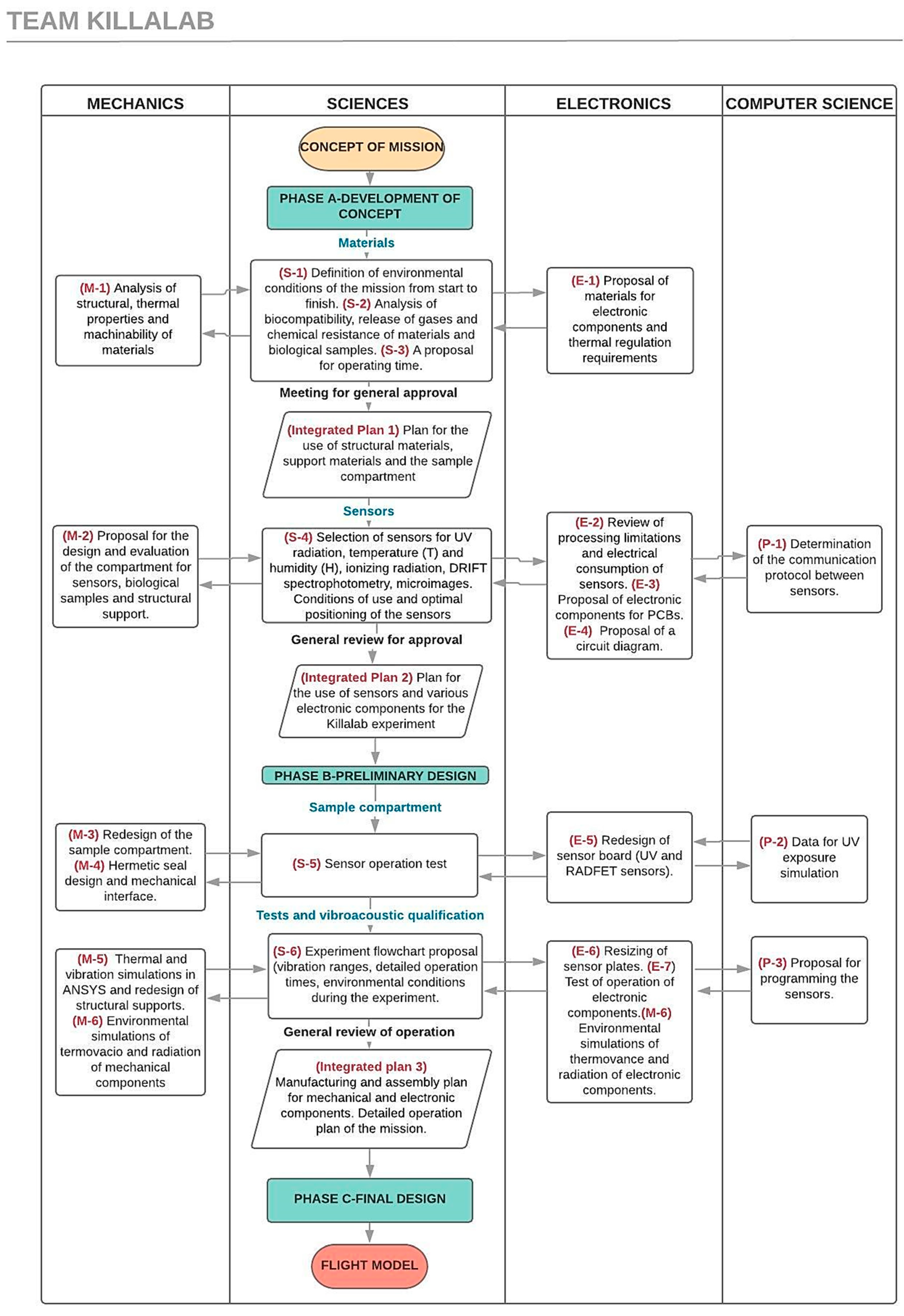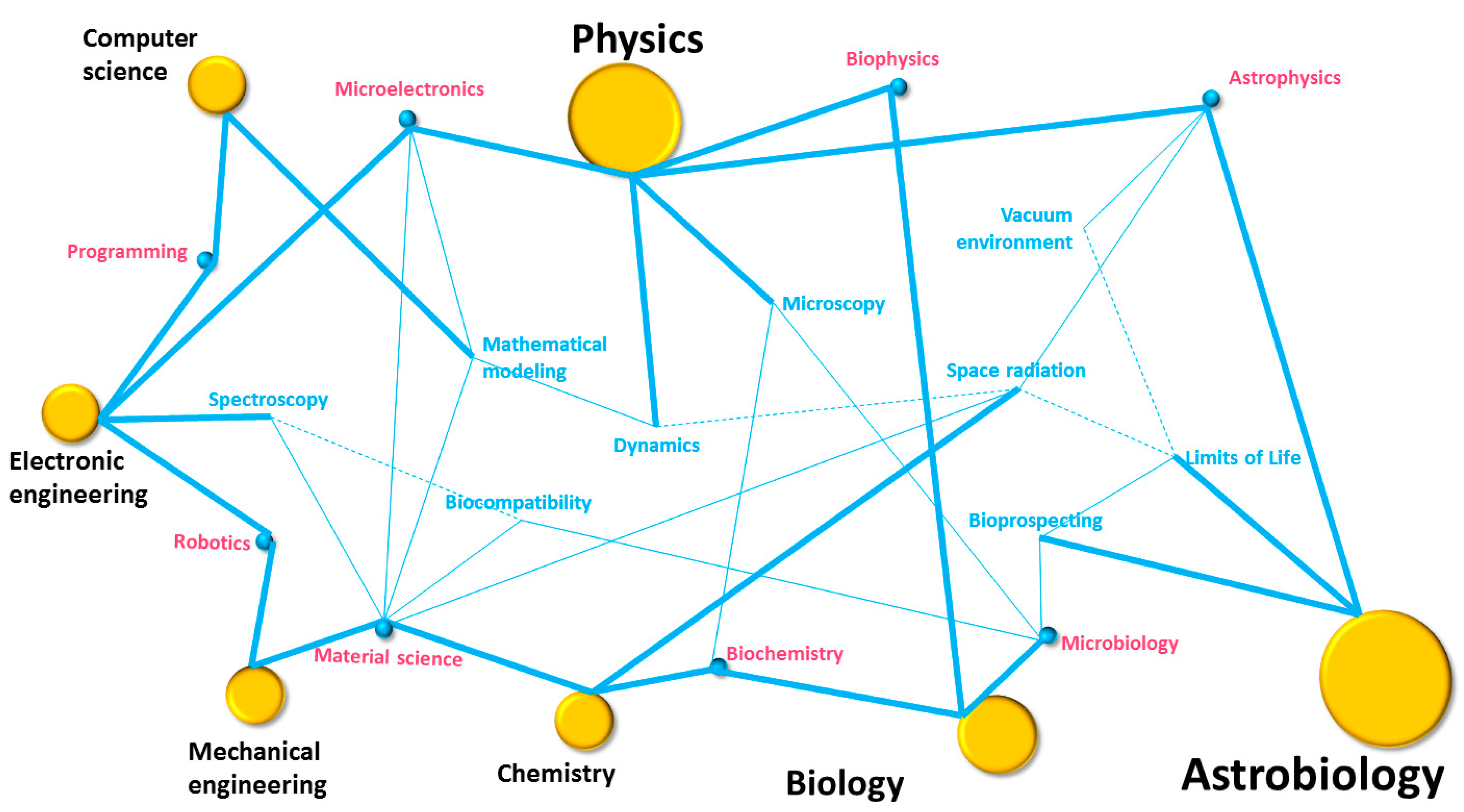Conformation of an Astrobiology Interdisciplinary Research Group: The “Team Killalab” Case Study †
Abstract
1. Introduction
2. Interdisciplinarity
3. Astrobiology as an Interdisciplinary Science
Development of Interdisciplinary Teams in Astrobiology
4. Methodology
4.1. Case Study
4.2. Research Settings
- A careful and strategic selection was made of the necessary disciplines and individual participants capable of occupying those positions [18]. These team members had to possess the characteristics of vision, dedication, reliability, ability to take responsibility for their limitations or errors, and ability to solve problems [19]. Thus, the members of the interdisciplinary team were expected to cooperate, share leadership, and demonstrate responsibility;
- The team members shared a commitment to completing the tasks required to meet the principal goal;
- Specific objectives for each scientific discipline were established after the complete conformation of the members of the team and after determining the principal goal in order to keep the team focused on the tasks that would solve a single problem, as other authors have suggested [20].
4.3. Data Collection
5. Results and Discussion
5.1. Team Killalab Discipline Conformation
5.2. Specific Objectives and Interaction of Tasks
5.3. Interdisciplinary Interaction within Team Killalab
6. Conclusions
7. Patents
Author Contributions
Funding
Conflicts of Interest
References
- Mazzocchi, F. Scientific research across and beyond disciplines. EMBO Rep. 2019, 20, e47682. [Google Scholar] [CrossRef] [PubMed]
- Bililign, S. The need for interdisciplinary research and education for sustainable human development to deal with global challenges. Int. J. Afr. Dev. 2013, 1, 8. [Google Scholar]
- Stopar, K.; Drobne, D.; Eler, K.; Bartol, T. Citation analysis and mapping of nanoscience and nanotechnology: Identifying the scope and interdisciplinarity of research. Scientometrics 2016, 106, 563–581. [Google Scholar] [CrossRef]
- Gowanlock, M.; Gazan, R. Assessing researcher interdisciplinarity: A case study of the University of Hawaii NASA Astrobiology Institute. Scientometrics 2013, 94, 133–161. [Google Scholar] [CrossRef][Green Version]
- Lungeanu, A.; Huang, Y.; Contractor, N.S. Understanding the assembly of interdisciplinary teams and its impact on performance. J. Inf. 2014, 8, 59–70. [Google Scholar] [CrossRef] [PubMed]
- Sephton, M.A. Astrobiology can help space science, education and the economy. Space Policy 2014, 30, 146–148. [Google Scholar] [CrossRef]
- Richter, D.M.; Paretti, M.C. Identifying barriers to and outcomes of interdisciplinarity in the engineering classroom. Eur. J. Eng. Educ. 2009, 34, 29–45. [Google Scholar] [CrossRef]
- National Academy of Sciences, National Academy of Engineering, and Institute of Medicine. Facilitating Interdisciplinary Research; The National Academies Press: Washington, DC, USA, 2005; p. 188. [Google Scholar]
- Aboelela, S.W.; Larson, E.; Bakken, S.; Carrasquillo, O.; Formicola, A.; Glied, S.A.; Haas, J.; Gebbie, K.M. Defining Interdisciplinary Research: Conclusions from a Critical Review of the Literature. Heal. Serv. Res. 2007, 42, 329–346. [Google Scholar] [CrossRef] [PubMed]
- Cornell, J.W. Mapping Disciplinary Relationships in Astrobiology: 2001–2012. Master’s Thesis, Western Washington University, Bellingham, WA, USA, 2014. [Google Scholar]
- Fischer, A.R.; Tobi, H.; Ronteltap, A. When Natural met Social: A Review of Collaboration between the Natural and Social Sciences. Interdiscip. Sci. Rev. 2011, 36, 341–358. [Google Scholar] [CrossRef]
- Tobi, H.; Kampen, J.K. Research design: The methodology for interdisciplinary research framework. Qual. Quant. 2018, 52, 1209–1225. [Google Scholar] [CrossRef] [PubMed]
- Des Marais, D.J.; Nuth III, J.A.; Allamandola, L.J.; Boss, A.P.; Farmer, J.D.; Hoehler, T.M.; Spormann, A.M. The NASA astrobiology roadmap. Astrobiology 2008, 8, 715–730. [Google Scholar] [CrossRef] [PubMed]
- Taşkın, Z.; Aydinoglu, A.U. Collaborative interdisciplinary astrobiology research: A bibliometric study of the NASA Astrobiology Institute. Scientometrics 2015, 103, 1003–1022. [Google Scholar] [CrossRef]
- Grotzinger, J.P.; Crisp, J.; Vasavada, A.R.; Anderson, R.C.; Baker, C.J.; Barry, R.; Blake, D.F.; Conrad, P.; Edgett, K.S.; Ferdowski, B.; et al. Mars Science Laboratory Mission and Science Investigation. Space Sci. Rev. 2012, 170, 5–56. [Google Scholar] [CrossRef]
- Vasavada, A.R.; Grotzinger, J.P.; Arvidson, R.E.; Calef, F.J.; Crisp, J.A.; Gupta, S.; Hurowitz, J.; Mangold, N.; Maurice, S.; Schmidt, M.E.; et al. Overview of the Mars Science Laboratory mission: Bradbury Landing to Yellowknife Bay and beyond. J. Geophys. Res. Planets 2014, 119, 1134–1161. [Google Scholar] [CrossRef]
- Yin, R.K. Case Study Research: Design and Methods; SAGE Publications Inc.: Thousand Oaks, CA, USA, 2003; p. 1. [Google Scholar]
- Morse, W.C.; Nielsen-Pincus, M.; Force, J.E.; Wulfhorst, J.D. Bridges and Barriers to Developing and Conducting Interdisciplinary Graduate-Student Team Research. Ecol. Soc. 2007, 12, 1–14. [Google Scholar] [CrossRef]
- Naiman, R.J. A Perspective on Interdisciplinary Science. Ecosystems 1999, 2, 292–295. [Google Scholar] [CrossRef]
- Koch, L.C.; Rumrill, P.D., Jr. The working alliance: An interdisciplinary case management strategy for health professionals. Work 1998, 10, 55–62. [Google Scholar] [CrossRef] [PubMed]
- VanWormer, A.; Lindquist, R.; Robiner, W.; Finkelstein, S. Interdisciplinary collaboration applied to clinical research: An example of remote monitoring in lung transplantation. Dimens. Crit. Care Nurs. 2012, 31, 202–210. [Google Scholar] [CrossRef] [PubMed]



| Discipline | Specific Goals |
|---|---|
| Biology | Study of the survival of cyanobacteria in the extreme conditions of space |
| Chemistry | Study of the chemical modification of the protective pigments of cyanobacteria |
| Physics | Evaluation of the physical conditions of a payload that can resist total components |
| Electrical engineering | Design of the electronics of the payload (minilaboratory) |
| Mechanical engineering | Design of the mechanics of the payload (minilaboratory) |
| Computer science | Gathering of data from simulations and real ultraviolet radiation exposure in outer space |
© 2019 by the authors. Licensee MDPI, Basel, Switzerland. This article is an open access article distributed under the terms and conditions of the Creative Commons Attribution (CC BY) license (http://creativecommons.org/licenses/by/4.0/).
Share and Cite
Quispe-Pilco, R.E.; Rodriguez-Venturo, S.C.A.; Cruz-Simbrón, R.L.; Ramírez-Gramber, J.J.; Vásquez-Ortiz, V.E.; Leonardo-Julian, C.; Valdivia-Silva, J.E.; Pérez-Montaño, H.S. Conformation of an Astrobiology Interdisciplinary Research Group: The “Team Killalab” Case Study. Proceedings 2019, 24, 2. https://doi.org/10.3390/IECG2019-06197
Quispe-Pilco RE, Rodriguez-Venturo SCA, Cruz-Simbrón RL, Ramírez-Gramber JJ, Vásquez-Ortiz VE, Leonardo-Julian C, Valdivia-Silva JE, Pérez-Montaño HS. Conformation of an Astrobiology Interdisciplinary Research Group: The “Team Killalab” Case Study. Proceedings. 2019; 24(1):2. https://doi.org/10.3390/IECG2019-06197
Chicago/Turabian StyleQuispe-Pilco, Ruth E., Sofia C.A. Rodriguez-Venturo, Rómulo L. Cruz-Simbrón, Jeffrey Javier Ramírez-Gramber, Víctor Eduardo Vásquez-Ortiz, Carlos Leonardo-Julian, Julio E. Valdivia-Silva, and H. Saul Pérez-Montaño. 2019. "Conformation of an Astrobiology Interdisciplinary Research Group: The “Team Killalab” Case Study" Proceedings 24, no. 1: 2. https://doi.org/10.3390/IECG2019-06197
APA StyleQuispe-Pilco, R. E., Rodriguez-Venturo, S. C. A., Cruz-Simbrón, R. L., Ramírez-Gramber, J. J., Vásquez-Ortiz, V. E., Leonardo-Julian, C., Valdivia-Silva, J. E., & Pérez-Montaño, H. S. (2019). Conformation of an Astrobiology Interdisciplinary Research Group: The “Team Killalab” Case Study. Proceedings, 24(1), 2. https://doi.org/10.3390/IECG2019-06197





